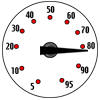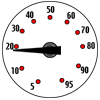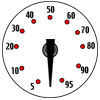Odor Fade
A phenomenon whereby the odorant placed in propane may become neutralized through oxidation. Although little is known of this phenomenon, new containers that have been improperly purged or older containers that have been left open to the atmosphere may be susceptible.
Online Payment
You may pay your invoice online by using the online payment link.
Click here to Make an Online Payment
Credit Card payments made within 10 business days of propane delivery are
entitled to a 10 cent per gallon discount.
POL
Prest-o-Lite fitting. A fitting used exclusively for flammable gases. Easily identified by the notches in the hex of the fitting. All POL fittings are tightened by turning counter-clockwise.
Propane's Odor
Propane's distinctive odor comes from the injection of no less than 1.5 pounds of ethyl-mercaptan per 10,000 gallons of liquid propane.
 |
Your ASME domestic container gauge as it appears when your container is full. 82% |
 |
Your ASME domestic container gauge as it appears when you are due for a delivery.
< 20% (Better contact us.) |
 |
Your ASME domestic container gauge as it appears when your container is empty.
Oh no! |
Regulator Installation
All regulators must be installed in such a manner as to protect the regulator vent from becoming plugged or impeded. Your second stage regulator must be installed at least four feet from any opening that leads to a below-grade area (basement or crawl-space) and at least ten feet from any potential source of ignition (electric service, furnace vent, air conditioner, etc.)
Second Stage Regulator
The regulator that decreases your first stage supply line pressure (~5 psi) to appliance service pressure (~4 oz / sq. in.) Your second stage regulator is typically attached to your building.
System Safety and Integrity Check
Performed by GASCO at the time of your intial installation. All system appliances are checked for proper installation, operation and venting. Your entire system is pressure checked over a 20 minute period to insure system integrity.
Tank Hood
The protective cover on top of your ASME container. Underneath your tank hood you will find your container gauge,
vapor service valve, first stage regulator, and the fill valve.
Most GASCO rental ASME domestic containers have a blue hood.
Vapor Service Valve
Located under your tank hood, connected to your first stage regulator. To close your vapor service valve, turn it in a clock-wise rotation. Doing this will shut off your gas supply from the container forward through your appliance service lines. This is your main gas service shutoff point.